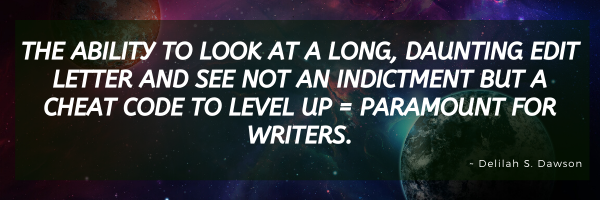Editing Letters… they are often the most beautiful and intimidating part of working with an editor. An editing letter exposes the soul of your book. It looks at all the weak points, highlights the flaws, and flails your ego with all the things that went terribly wrong. A good editing letter is often soul-crushing. But, as the very wise Delilah Dawson said, once you’re done crying you’ll see that the editing letter is a cheat code.
How To Write An Editing Letter
First and foremost you need to learn how to stop seeing your book as Your Book and start seeing it as Just A Book. This is the hardest editing skill to learn. It is also the most necessary.
Offer yourself a bribe and get on with it. You’re editing this book because you want it to be awesome and that means admitting that the first draft wasn’t flawless. Grab a glass of water and take it like a champ.
Second, you will need a copy of your manuscript in a different format than you wrote it in. That means changing the font on your computer, printing, or (my preferred method) putting it in ebook format. If you don’t have a copy of Calibre yet I recommend that. It’s much easier to read your book on an ereader than sort through papers. But, do what brings you joy and what’s easiest for you. I now some people are die-hard fans of paper and ink.
Third, get a notebook and pen. You aren’t actually marking the manuscript in this edit because it’s tedious, time consuming, and very easy to lose edits. I’ve tried that method. I hate that method. If that’s your method, that’s fine, you do you… I recommend a pen and notebook.
Fourth, get comfy and start reading.
Fifth, every time you see something wrong, make a note in your notebook. Page numbers don’t always work for this because the pages will change once you start editing. I recommend writing a few of the words down so you can search for phrases during the edit. Make note of every grammar error, typo, weak prose… anything. Everything. Is a subplot missing? Does a character’s actions seem unusual? Make a note.
Sixth, finish reading before you start editing. Right now you are an editor, not an author. You are not touching the manuscript at all. You are recording everything in your notebook.
Congratulations! You survived!
Take a break. Write a short story. Read some other books. Erase as much of this from your memory as you can. And then it’s on to the next part…
How To Read An Editing Letter
First, take a deep breath. You’ve come a long way and now you’re going to face the daunting task of figuring out how to make this book the best book possible. You should be proud of yourself.
Second, read the letter without the manuscript open. This can take several hours (if you’re on a tight deadline) or a few weeks. What you want to do is read through the letter, understand it, and then think about it. This is crucial. Most of this stage of editing is happening in your head. You need to think.
Third, identify what reoccurring problems you have. Maybe you’re off theme. Maybe one character’s POV is stilted. Maybe it’s the same problem you had with an older book, maybe it’s something new. Figure out how you’re fixing this.
Fourth, start planning what you need to add and subtract from the book. Do you need to add new scenes? Do you need to lose an entire character? Make a plan.
Fifth: Work The Plan. You know what needs to be done. You have a plan for handling it. Now it’s time to open the manuscript and get to work.
Happy editing!
Want to read the whole series on editing now? It’s on Patreon!



